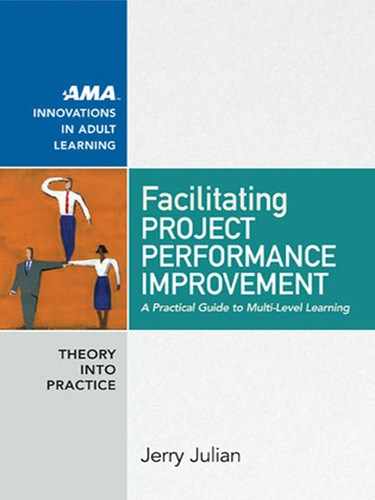Facilitating Level 2: Cross-Project Improvement 139
American Management Association
www.amanet.org
OVERVIEW OF LEVEL 2: CROSS-PROJECT IMPROVEMENT
The goal of Level 2 is to provide a mechanism for continually improv-
ing performance across multiple projects. Cross- project improvement is
di erent from Six Sigma or other process improvement methodologies
that use a “waterfall” approach. Rather than following a sequential proj-
ect plan that steps through the phases of de ne, measure, analyze, and
improve, cross- project improvement is an iterative approach. It starts with
data from project- level retrospectives and an improvement goal. Project
managers then try new approaches on real projects while they are in prog-
ress, enabling them to re ect collectively on ways to improve processes.
This action- re ection cycle is repeated as necessary until the improvement
goal is achieved. Consistent with the principles of multi- level learning dis-
cussed in Chapter 2, cross- project improvement is focused on eliminating
waste, delivering as fast as possible, and seeing the whole with the help of
an objective, substantively neutral third- party coach. Questions include:
What patterns are emerging from project retrospectives that appear to be
a ecting many projects? Which improvements that were made by speci c
teams can be shared across other projects? Which cross- project activities
are consuming the most time and resources, and what can be done to
make them more e ective?
Both the multi- level learning coach and the program manager or pro-
gram management o ce (PMO) provide an important function. As noted
in Chapter 3, the multi- level learning coach has no decision- making au-
thority and serves as a substantively neutral third party. She works with the
program management o ce to plan and conduct regular action- re ection
cycles with project managers and other subject- matter experts from across
the project organization. A key function of the PMO at this level is to
incorporate improvements and innovations into the organization’s pro-
cesses, systems, and methodologies so that future teams can use them.
Chapter 4 discussed in detail how PMO leaders broker knowledge in this
way, enabling the organization to incorporate ongoing improvements in
ways that enable systems- level learning.
Having covered the goals and roles required for cross- project improve-
ment, we now turn to the steps required to make it happen. As shown
in Figure 6.1, these steps include (1) plan and conduct the cross- project
..................Content has been hidden....................
You can't read the all page of ebook, please click here login for view all page.
